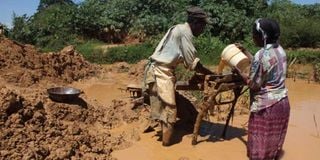Gold yet to make western Kenya glitter decades later

Artisanal miners prospect for gold in Rosterman in Kakamega County.
That western Kenya is sitting on large deposits of gold could be a reality that is yet to come to the surface.
Bushiangala and Isulu villages in Ikolomani, Kakamega County are said to be the bedrock of the precious metal but it is the visible poverty among residents that tells a different story.
There is no presence of large-scale mining nor any proof that the mineral is economically viable despite the many years of exploration by international firms that keep exchanging hands over the years since the pre-colonial era.
This has largely left the venture to small-scale artisanal miners who are ill-equipped, forcing them to dig out deep shafts in search of the mineral, at least to earn a living that at times comes with death.
But on the waiting line are middlemen scavenging the area, taking advantage of small scale miners exploiting them as they lack exposure to the gold market.
We met Mr Benedict Khayego at his work station at Bushiangala going about gold mining. For 38 years now, he has been an artisanal gold miner, getting into the deep shafts to scoop the valuable mineral.
The 52-year-old, having ventured into gold mining at a tender age, chairs the Indombero Mining Artisanal Miners group that has a membership of 46 people.
His day and that of the other group members starts at 8am and closes at 5pm, but they at times spend the night in the shafts, depending on the day's work.
Seven shafts
He says they own seven shafts on a piece of land they leased to enable them undertake small scale gold mining.
The farm located off the Musoli-Bushiangala road has been their place of work over the years and he says they have always earned a living from the dangerous shafts.
Sometimes they are filled with water, forcing them to spend much time drawing it out before digging into the soil.
Khayego says they lack machines to undertake large scale mining and that they rely on the holes that were made by the Europeans who conducted exploration and mining activities in the areas in the 1950s and lately.
And after the sweat, they sell a gramme of gold for Sh5,000 to middlemen who in return reap a lot of money on reselling with minimal sweat. But for the artisanal miners, this is a good hustle for them as it enables them to get some money.
A few metres from the Indombero Mining Artisans group, another set of miners – made up of women – is setting up a gold mining site.
The group is yet to give itself a name. It is composed of women who broke up from Rock Mining group, in search of their independence. They want to undertake the activity that is normally a men’s affair. Ms Scholastica Daudi is acting as their chairlady while Ms Mable Chanzu is the secretary.
“We have started this group and will soon give it a name. Men were mistreating us in the other group. There is hope of gold being found,” says Ms Daudi.
Artisanal miners are, however, facing a challenge of being evicted for lack of license. Mr Khayego complains that Shanta gold, the exploration firm that has seven prospecting licenses, is asking them to abandon their shafts as the sites now belong to them.
Shanta acquired the project from Barrick Gold last year and is exploring for the mineral in three locations of Shisele, Isulu and Shirumba.
Small artisanal industry
It is believed Ikolomani has been sitting on gold since 1932 when colonialists discovered the metal in this area with local corrupting the name gold mine
Europeans conducted extensive exploration and mining up to 1952 and left, leaving Africans who were working on their farms to continue doing small-scale prospecting for gold and set up a small artisanal industry in Idakho.
Khwisero, Kakamega East, Luhrambi and Ikolomani that form the extensive Lihranda gold corridor are the four leading mining sites in the region.
In its regular updates released early this month, Shanta Gold says it has found the fourth hole with visible gold at Bushangala after reaching 3,205 metres.
Chief executive, Mr Eric Zurin, notes that the firm is almost halfway through its total planned infill drilling programme in western Kenya for 2021.
He exudes confidence that they will be able to release a source update later this month,
“We are delighted with our second set of results from phase two of drilling at West Kenya. While the intersections across the board have been very strong, we are particularly pleased with a new intersection of 3.9m at 63.80 g/t Au which is 60 meters in proximity to the undisclosed hole announced last month which intersected 4.0m at 706.3 g/t," says Mr Zurin.





